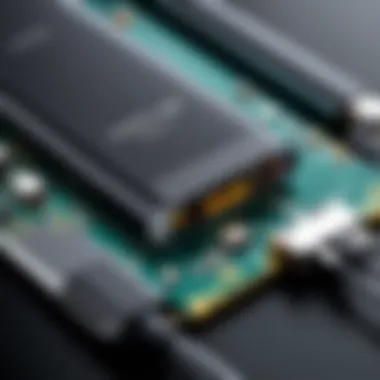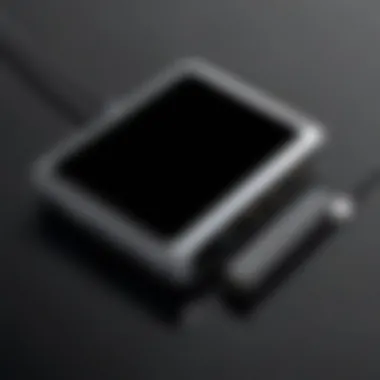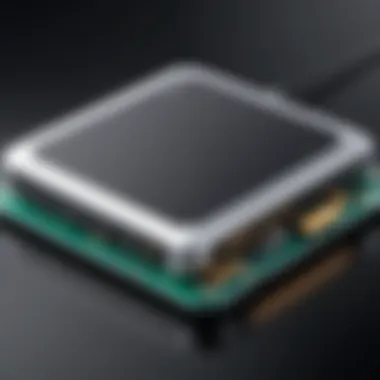In-Depth Guide to USB-C Power Delivery Battery Packs


Intro
The rapid evolution of mobile devices has led to an increasing reliance on effective power solutions. As technology advances, USB-C Power Delivery (PD) battery packs are gaining prominence. These battery packs offer a blend of high capacity and efficiency, making them a valuable asset for both casual users and industry professionals.
This article delves into various aspects of USB-C PD battery packs, aiming to provide thorough insight for IT professionals and tech enthusiasts. We will explore the hardware and software components, performance metrics, and key specifications that define these devices. By understanding USB-C PD technology, readers will be equipped to make informed decisions when selecting the right battery pack for their needs.
Hardware Overview
USB-C PD battery packs are designed with specific hardware features that enhance their functionality and performance. Understanding these can help users appreciate their value and make more prepared choices.
Specifications
The core specifications of USB-C PD battery packs typically include:
- Port types: Most packs feature USB-C ports, supporting both input and output.
- Battery capacity: Measured in milliampere-hours (mAh), indicating how much energy a battery can store.
- Power output: Defined in Watts, dictating the speed and efficacy at which devices can be charged.
- Charging protocols: Compatibility with PD standards ensures optimal charging across devices.
These specifications vary among products, so it is essential to consider what best meets individual needs.
Performance Metrics
Performance metrics provide insight into how effectively USB-C PD battery packs function. Some key metrics include:
- Charging time: The duration required to fully charge the pack itself and connected devices.
- Number of charge cycles: This indicates the longevity of the battery before its capacity declines.
- Efficiency: A measure of how much energy is lost during charging and discharging processes.
Understanding these metrics is vital for users to gauge the practicality of different battery packs for their specific use cases.
"USB-C Power Delivery technology revolutionizes the way we charge and power our devices, offering remarkable efficiency and convenience."
Software Analysis
While hardware is critical, software also plays a significant role in maximizing the utility of USB-C PD battery packs.
Features and Functionality
Common software features include:
- Smart charging: This technology adjusts power output based on device requirements to prevent overheating and prolong battery life.
- Battery management systems: These systems monitor health and performance, ensuring optimal functioning.
- Firmware updates: Regular updates can enhance performance and security protocols for users.
These features contribute to a better overall experience by improving usability and efficiency.
User Interface and Experience
The user interface on many USB-C PD battery packs is intuitive, often featuring LED indicators to show battery level and charging status. Some advanced models include mobile app connectivity, allowing users to monitor battery status and customize settings from their smartphones.
Closure
In summary, USB-C PD battery packs are essential tools in today's tech landscape. Understanding their specifications, performance metrics, and software functionalities enables users to select the right battery pack to meet their needs. This exploration into USB-C PD technology reveals its significance in enhancing our interactions with modern gadgets.
Prologue to USB-C Power Delivery
USB-C Power Delivery (PD) serves as a pivotal advancement in the landscape of device charging and data transmission. Its emergence has redefined how we connect and power our devices, making it essential for tech enthusiasts and IT professionals to grasp the nuances of this technology. In this section, we will delve into its definition and historical context, laying the groundwork for a more profound understanding of USB-C PD battery packs.
Definition of USB-C PD
USB-C Power Delivery is a specification that allows for faster and more efficient charging through USB Type-C connectors. Unlike traditional USB charging methods, USB-C PD can deliver significantly more power, ranging anywhere from 10 watts to 100 watts. This capability enables various devices, including laptops, smartphones, and tablets, to be charged quickly and effectively.
Moreover, USB-C PD supports two-way power transfer, meaning devices can either receive or supply power. This feature empowers various use cases, such as charging a laptop while simultaneously powering a peripheral. The versatility of USB-C PD stands in stark contrast to previous charging protocols, where power direction was often limited and less adaptable to various device needs.
History of USB Technology


The history of USB technology dates back to the mid-1990s. The aim was to create a standard interface that could facilitate seamless connectivity between peripherals and computers. Initially, USB 1.0 was introduced with a modest transfer rate of 1.5 MB/s. It provided a degree of convenience, but as technology advanced, the limitations of USB began to surface.
In 2000, USB 2.0 came onto the scene, improving data transfer speeds and expanding device compatibility. It continued to evolve into USB 3.0 and later, with USB 3.1 and USB 3.2, introducing greater speeds up to 20 Gbps. However, it wasn't until the advent of USB-C in 2014 that the connection format truly changed.
USB-C offered a reversible connector and enhanced capabilities for power delivery and data transfer. The introduction of Power Delivery further propelled this technology into a modern standard, catering to the increasing power needs of contemporary devices. As a result, USB-C PD has become the go-to solution for many manufacturers, reinforcing its significance in today's tech landscape.
"USB-C Power Delivery is not just an improvement; it's a transformation that changes how we interact with and power our devices."
Through these developments, USB-C PD plays a critical role in enabling faster charging and enhancing user experience across the electronics spectrum. Understanding its definition and historical progression sets the foundation for grasping the impact of USB-C PD battery packs in modern technology.
Understanding Battery Packs
Batteries are the lifeblood of modern portable electronic devices. As technology advances, so does the need for effective power sources. Understanding battery packs allows users to select better options for their devices. This section focuses on the essential elements that comprise battery technology and different types available in the market. Battery packs can vary greatly in chemistry, capacity, and design. Hence, knowing which type suits your needs can enhance your experience with devices.
Basics of Battery Technology
Battery technology is a critical component of modern electronics. To grasp how USB-C PD battery packs function, one must understand the basic principles of batteries. A battery comprises electrochemical cells that store energy and convert that stored energy into electrical power. This process is essential for charging and powering devices.
Two primary characteristics in battery technology include capacity and voltage. Capacity, measured in milliampere-hours (mAh), signifies how much energy the battery can store. Voltage indicates the electrical potential of the battery. Typically, a higher capacity means longer usage times, while the voltage affects charging speeds and compatibility with devices.
"Understanding battery packs enables smarter purchasing decisions that align with device requirements and user expectations."
Types of Battery Packs
Different types of battery packs exist, each with unique properties and benefits. Evaluating these types can help determine the most suitable pack for your devices. Two well-known types are Lithium-ion and Nickel-Metal Hydride (NiMH) battery packs.
Lithium-ion Battery Packs
Lithium-ion battery packs are one of the most used battery types in modern electronics. Their key characteristic includes high energy density. This means they can store a large amount of energy relative to their size. This property makes them ideal for compact devices like smartphones and laptops.
A unique feature of Lithium-ion battery packs is their low self-discharge rate. This allows them to retain their charge for extended periods without being in use. Advantages include fast charging capabilities and lightweight composition. However, they come with some drawbacks such as sensitivity to temperature changes and shorter lifespan compared to other chemistries in certain conditions.
NiMH Battery Packs
Nickel-Metal Hydride (NiMH) battery packs offer another option. They are known for having a higher capacity than traditional Nickel-Cadmium (NiCd) batteries, which makes them a beneficial choice for many applications. NiMH batteries are often more environmentally friendly than their lithium counterparts due to less toxic materials.
A unique feature of NiMH battery packs is their ability to tolerate deep discharges without significant cell damage. This characteristic can lead to longer effective usage in lower-power devices but may result in a more rapid self-discharge than lithium-ion packs.
In summary, understanding battery packs goes beyond just knowing how they work. It involves recognizing the best fit for specific technology needs, ensuring devices function efficiently and effectively.
How USB-C Power Delivery Works
Understanding how USB-C Power Delivery operates is crucial for both IT professionals and tech enthusiasts. This technology simplifies the way devices communicate and charge, leading to enhanced efficiency and usability. As technology evolves, the need for faster and more reliable power solutions has grown. USB-C Power Delivery meets these needs by allowing various devices to negotiate power levels seamlessly, adapting to their specific requirements. This not only minimizes charging times but also enhances the overall user experience.
Power Negotiation Process
The power negotiation process is a key element of USB-C Power Delivery that ensures devices operate safely and effectively. It involves dynamic communication between the charger and the device. When a device is connected to a power supply, a 'handshake' occurs. This handshake determines how much power the device can receive based on its needs and the capabilities of the power source.
During this process, devices can request different power profiles. For example, a smartphone may only need 18 watts to charge efficiently, while a laptop may require up to 100 watts. This negotiation not only ensures that devices receive the right amount of power but also protects them from receiving too much, which could cause damage. This intelligent management promotes safety and efficiency, making the USB-C Power Delivery a critical advancement in battery pack technology.
Wattage Specifications
Wattage specifications define the amount of power that USB-C PD technology can deliver. USB-C PD supports a broad range of wattage levels, starting from as low as 5 watts and reaching up to 100 watts. This versatility allows a single port to charge multiple devices, from small gadgets like smartphones to larger devices like laptops.
It is important to choose a USB-C PD battery pack that matches your device’s wattage needs. For instance:
- Smartphones generally require less wattage, typically between 18 and 20 watts.
- Tablets may require up to 30 watts.
- Laptops can demand up to 100 watts depending on the model.
By adhering to these specifications, users can ensure optimal charging.


"The ability to negotiate power levels dynamically is what sets USB-C PD apart in the current landscape of charging technologies."
Advantages of USB-C PD Battery Packs
The rise of USB-C Power Delivery (PD) technology has significantly transformed the way we interact with battery packs. Their advantages stretch beyond mere convenience; they address fundamental issues of charging speed, device compatibility, and energy efficiency. Understanding these benefits is crucial for both IT professionals and tech enthusiasts, as it influences purchasing decisions and overall user experience.
Fast Charging Capabilities
One of the standout features of USB-C PD battery packs is their ability to deliver fast charging capabilities. Traditional USB chargers have limitations; they rarely exceed 2.4A or 12W of power. In contrast, USB-C PD can adjust from 5W to 100W, depending on the device and requirements. This means a device such as a laptop can be charged in significantly less time compared to using standard methods.
Charging efficiency matters. With faster charging, users can minimize downtime. For example, a MacBook Pro can be charged up to 50% in just around 30 minutes with a compatible USB-C PD power source compared to hours with older charging technologies. This speed is particularly advantageous for people on the go, making USB-C PD battery packs an essential tool for professionals who rely on their devices.
"USB-C PD can deliver up to 100 Watts of power, opening the door for charging larger devices like laptops quickly and efficiently."
Universal Compatibility
Another considerable advantage is the universal compatibility that USB-C PD battery packs offer. Unlike proprietary charging systems, which often require specific cables and adapters, USB-C is becoming a standard across a range of devices. This includes smartphones from Apple and Samsung, tablets, laptops, and even some gaming consoles. Therefore, carrying one USB-C PD battery pack could suffice for multiple devices.
This compatibility streamlines the user experience. It reduces the clutter of different chargers and cables and eases the burden on users who carry multiple gadgets. Moreover, as the tech landscape continues to converge towards USB-C, investing in USB-C PD battery packs prepares users for greater flexibility and adaptability in the future.
In summary, the advantages of USB-C PD battery packs encompass fast charging capabilities and universal compatibility, thereby enhancing the user experience significantly. These aspects not only cater to practical needs but also align with an evolving technology ecosystem that emphasizes efficiency and accessibility.
Key Features to Consider When Selecting USB-C PD Battery Packs
When choosing USB-C PD battery packs, it is essential to focus on several key features. The right battery pack can significantly affect device performance and user satisfaction. Below are the critical aspects to consider when making a selection.
Capacity and Voltage Ratings
The capacity of a battery pack, typically measured in milliamp hours (mAh), determines how long a device can run before needing a recharge. A higher capacity usually means longer usage times. However, it's important to match the capacity with the device’s requirements. Voltage ratings also play a pivotal role in performance. Ensure the battery pack's voltage aligns with what your device needs. This helps prevent potential damage and ensures effective charging. Battery packs with adjustable voltage settings can be more versatile, providing users the flexibility to power varied devices efficiently.
Size and Portability
The size and portability of a USB-C PD battery pack cannot be underestimated. A compact and lightweight design is desirable for users who need power on the go. Finding a balance between capacity and size is critical. Larger capacity packs may offer prolonged power but at the cost of portability. Consider designs that fit easily into bags or pockets for convenient travel. Dimensions and weight should be carefully evaluated relative to the expected use case, especially for frequent travelers or users with limited carrying capacity.
Durability and Build Quality
Durability is another key feature when selecting a USB-C PD battery pack. Battery packs are often exposed to various environmental conditions. Thus, opting for models with robust build quality can lead to enhanced longevity. Look for packs made of durable materials that can withstand drops, spills, and exposure to heat. Features like overcharge protection and a secure casing can further enhance safety and performance. A well-constructed battery pack not only extends its life span but also protects your devices from potential hazards caused by poor-quality products.
"Investing in a reliable USB-C PD battery pack protects your devices and enhances overall user experience."
In summary, understanding and considering these key features—capacity and voltage ratings, size and portability, and durability and build quality—can greatly influence your decision. Make informed choices to ensure the selected USB-C PD battery pack serves your needs effectively.
Potential Applications of USB-C PD Battery Packs
The rise of USB-C Power Delivery (PD) battery packs is transforming numerous tech products in ways that improve efficiency and functionality. The significance of these battery packs across various applications cannot be overstated. USB-C PD battery packs provide fast charging, allowing devices to recharge quickly, which helps in maintaining productivity and minimizing downtime. Their versatility in supporting multiple device types makes them an invaluable asset in both personal and professional environments.
Smartphones and Tablets
Smartphones and tablets are prime beneficiaries of USB-C PD technology. As consumers increasingly rely on these devices for both communication and work, the need for reliable and fast charging solutions becomes essential. USB-C PD battery packs offer a notable advantage by delivering the necessary power to charge these devices rapidly without overheating or causing damage.
The benefits of using USB-C PD battery packs with smartphones and tablets include:
- Fast Charging: Many smartphones now support rapid charging, enabling a full charge in less than an hour, thanks to USB-C PD.
- Universal Compatibility: A single battery pack can charge various devices, minimizing the need for multiple chargers.
- Smart Power Allocation: These battery packs can regulate wattage demand, allowing them to adjust based on the connected device.
Consider the practicality of power banks designed specifically for smartphones—like the Anker PowerCore III Slim or Zendure SuperTank—many brands enhance their products with USB-C PD support. Users enjoy seamless integration, as functionality and portability align.
Laptops and Other Devices
Laptops have also greatly benefitted from the advancements in USB-C PD battery packs. With the shift towards more portable computing solutions, such as ultrabooks and 2-in-1 devices, an efficient power bank is crucial. USB-C PD battery packs support high wattage delivery, ensuring that laptops receive adequate power while on the go.


Key elements to consider for laptops include:
- Extended Usage: Increased power allows for longer usage periods without needing to find an outlet.
- Diverse Device Support: USB-C PD battery packs can charge monitors, cameras, and other peripherals, enhancing their usability across multiple platforms.
- Robust Design: Many laptop-oriented power banks come with protective features to prevent overheating and electrical surges.
Products like the RAVPower 60W USB-C Portable Charger or the Omnicharge Omni 20+ provide flexible charging options for devices requiring higher watts. Such versatility makes USB-C PD battery packs indispensable tools for those in tech-heavy professions.
"USB-C PD technology enables a more efficient and versatile power solution that aligns with modern device requirements and user expectations."
In essence, the applications of USB-C PD battery packs stretch well beyond mere convenience. Their capability to adapt across multiple devices is not just beneficial but has become necessary in a world that values speed and efficiency.
Recent Trends in the USB-C PD Market
The USB-C Power Delivery (PD) market has seen remarkable advancements and shifts in recent years. Understanding these trends is crucial for IT professionals and tech enthusiasts alike. The growing implementations of USB-C PD charging solutions are reshaping how devices are powered and opened new possibilities in the tech landscape. This section delves into the recent growth of USB-C PD adoption and highlights innovations in battery technology, which are pivotal in enhancing user experiences and driving the market forward.
Growth of USB-C PD Adoption
In the past few years, the adoption of USB-C PD technology has accelerated significantly. Various factors have contributed to this trend:
- Many new devices now come equipped with USB-C ports, making them more versatile.
- Major tech companies like Apple, Samsung, and Google have embraced USB-C standards.
- The increasing need for fast charging solutions has prompted users to seek USB-C PD battery packs.
Statistical evidence suggests that the rate of adoption is not only increasing but is also resulting in a broader range of compatible devices. Consumers now expect seamless and efficient charging solutions. This shift represents a fundamental change in how power delivery is viewed. As the demand continues to grow, manufacturers must innovate and adapt to user needs.
"The expansion of USB-C PD technology signifies a progressive transition toward a more unified charging standard across devices."
Innovations in Battery Technology
Innovations in battery technology are essential for keeping pace with the rapid advancements in USB-C PD. Here are some notable developments:
- Higher Energy Density: New battery chemistries are being developed that increase energy density, enabling longer usage times with smaller battery sizes. This is vital for portable devices where space is limited.
- Faster Charge Times: Improvements in charging technology allow for faster replenishment of battery packs. Users are benefiting from shorter wait times.
- Smart Features: Some newer battery packs now come with integrated management systems that optimize charging cycles and enhance safety.
These trends not only cater to current device requirements but also pave the way for future innovations. As the ecosystem evolves, understanding these trends ensures users make informed decisions regarding their USB-C PD battery packs.
Future Outlook for USB-C PD Battery Packs
The future outlook for USB-C Power Delivery (PD) battery packs is significant in shaping the energy landscape for mobile and portable devices. As the reliance on mobile technology increases, these battery packs will play a crucial role in ensuring users have the necessary power to support their devices throughout the day. The trends and advancements in this arena are not just technical but also reflect changing consumer needs and environmental considerations.
Emerging Technologies
In the coming years, innovations in battery technology will shape the development of USB-C PD battery packs. One area of focus is solid-state batteries. These batteries promise higher energy density and improved safety features. They could lead to lighter and more compact battery packs without sacrificing performance. Different from traditional lithium-ion batteries, solid-state batteries use a solid electrolyte instead of liquid. This change can increase efficiency and lead to reduced charging times.
Another exciting development relates to energy management systems. Advanced smart technology embedded in USB-C PD battery packs will allow devices to communicate more effectively about their power needs. This could optimize charging cycles and extend battery life significantly.
Additionally, integration with renewable energy sources presents another area of growth. Solar-powered USB-C PD battery packs may become more commonplace, offering consumers the option to utilize clean energy. This integration addresses ecological concerns while harnessing the growing trend towards sustainable technology.
Potential Challenges Ahead
Despite the optimistic developments, several challenges lay ahead for the widespread adoption of USB-C PD battery packs. First, standardization will be critical. While USB-C PD has established itself, variations in manufacturer implementations can create confusion. Compatibility issues may arise if devices do not adhere to the same charging protocols.
Moreover, the rapid pace of innovation may lead to market saturation. As various brands release USB-C PD battery packs with varying features, consumers might find it hard to choose the right product for their needs. Ultimately, the key will be marketing strategies that effectively communicate value and benefits to consumers.
Environmental concerns also pose challenges. The manufacturing and disposal of batteries have significant ecological impacts. As USB-C PD battery packs become more popular, the industry must focus on recycling methods and the use of eco-friendly materials to minimize harm to the environment.
Closure
Summary of Key Points
In this article, we have extensively explored USB-C Power Delivery (PD) battery packs, emphasizing their significance in today's technological landscape. Notably, we have examined the definition and evolution of USB technology, the advantages offered by USB-C PD battery packs, and the key features to consider when selecting these devices. The potential applications of these battery packs in personal gadgets like smartphones, tablets, and laptops were also discussed. Furthermore, we highlighted recent trends in the USB-C PD market, including the ongoing growth and innovation in battery technology. Such information provides valuable insights for both IT professionals and tech enthusiasts.
"USB-C PD battery packs represent a convergence of convenience and advanced charging technology, reshaping how we approach portable power solutions."
Final Thoughts on USB-C PD Battery Packs
The future of USB-C PD battery packs appears promising, characterized by emerging technologies and innovative solutions designed to overcome current limitations. As devices continue to evolve, the need for efficient, high-capacity, and versatile battery packs will only increase. Understanding these dynamics can help users choose the most suitable products for their requirements.
In summary, the USB-C PD battery packs are not just a trend; they represent a shift toward a more integrated approach to powering our devices efficiently. Individuals and organizations focusing on technology should remain informed about these developments to enhance their productivity and devices' usability.



